Reversal of age-related learning deficiency by the vertebrate PACAP and IGF-1 in a novel invertebrate model of aging: the pond snail (Lymnaea stagnalis)
- PMID: 24846768
- PMCID: PMC4197904
- DOI: 10.1093/gerona/glu068
Reversal of age-related learning deficiency by the vertebrate PACAP and IGF-1 in a novel invertebrate model of aging: the pond snail (Lymnaea stagnalis)
Abstract
With the increase of life span, nonpathological age-related memory decline is affecting an increasing number of people. However, there is evidence that age-associated memory impairment only suspends, rather than irreversibly extinguishes, the intrinsic capacity of the aging nervous system for plasticity (1). Here, using a molluscan model system, we show that the age-related decline in memory performance can be reversed by administration of the pituitary adenylate cyclase activating polypeptide (PACAP). Our earlier findings showed that a homolog of the vertebrate PACAP38 and its receptors exist in the pond snail (Lymnaea stagnalis) brain (2), and it is both necessary and instructive for memory formation after reward conditioning in young animals (3). Here we show that exogenous PACAP38 boosts memory formation in aged Lymnaea, where endogenous PACAP38 levels are low in the brain. Treatment with insulin-like growth factor-1, which in vertebrates was shown to transactivate PACAP type I (PAC1) receptors (4) also boosts memory formation in aged pond snails. Due to the evolutionarily conserved nature of these polypeptides and their established role in memory and synaptic plasticity, there is a very high probability that they could also act as "memory rejuvenating" agents in humans.
Keywords: Learning; Memory.; PACAP.
© The Author 2014. Published by Oxford University Press on behalf of The Gerontological Society of America.
Figures
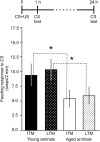
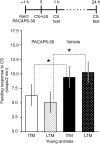
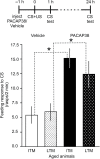
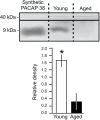
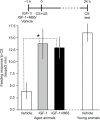
Similar articles
-
Same same, but different: exploring the enigmatic role of the pituitary adenylate cyclase-activating polypeptide (PACAP) in invertebrate physiology.J Comp Physiol A Neuroethol Sens Neural Behav Physiol. 2024 Nov;210(6):909-925. doi: 10.1007/s00359-024-01706-5. Epub 2024 Jun 28. J Comp Physiol A Neuroethol Sens Neural Behav Physiol. 2024. PMID: 38940930 Free PMC article.
-
A homolog of the vertebrate pituitary adenylate cyclase-activating polypeptide is both necessary and instructive for the rapid formation of associative memory in an invertebrate.J Neurosci. 2010 Oct 13;30(41):13766-73. doi: 10.1523/JNEUROSCI.2577-10.2010. J Neurosci. 2010. PMID: 20943917 Free PMC article.
-
Pituitary adenylate cyclase activating polypeptide (PACAP) and its receptors are present and biochemically active in the central nervous system of the pond snail Lymnaea stagnalis.J Mol Neurosci. 2010 Nov;42(3):464-71. doi: 10.1007/s12031-010-9361-x. Epub 2010 Apr 16. J Mol Neurosci. 2010. PMID: 20396976
-
Environmentally relevant stressors alter memory formation in the pond snail Lymnaea.J Exp Biol. 2014 Jan 1;217(Pt 1):76-83. doi: 10.1242/jeb.089441. J Exp Biol. 2014. PMID: 24353206 Review.
-
Lymnaea stagnalis as model for translational neuroscience research: From pond to bench.Neurosci Biobehav Rev. 2020 Jan;108:602-616. doi: 10.1016/j.neubiorev.2019.11.020. Epub 2019 Nov 28. Neurosci Biobehav Rev. 2020. PMID: 31786320 Review.
Cited by
-
Mesenchymal stem cells-based therapy as a potential treatment in neurodegenerative disorders: is the escape from senescence an answer?Neural Regen Res. 2015 Jun;10(6):850-8. doi: 10.4103/1673-5374.158352. Neural Regen Res. 2015. PMID: 26199588 Free PMC article. Review.
-
Same same, but different: exploring the enigmatic role of the pituitary adenylate cyclase-activating polypeptide (PACAP) in invertebrate physiology.J Comp Physiol A Neuroethol Sens Neural Behav Physiol. 2024 Nov;210(6):909-925. doi: 10.1007/s00359-024-01706-5. Epub 2024 Jun 28. J Comp Physiol A Neuroethol Sens Neural Behav Physiol. 2024. PMID: 38940930 Free PMC article.
-
Identification of Putative Molecules for Adiponectin and Adiponectin Receptor and Their Roles in Learning and Memory in Lymnaea stagnalis.Biology (Basel). 2023 Feb 27;12(3):375. doi: 10.3390/biology12030375. Biology (Basel). 2023. PMID: 36979067 Free PMC article.
-
Neuropeptide Localization in Lymnaea stagnalis: From the Central Nervous System to Subcellular Compartments.Front Mol Neurosci. 2021 May 20;14:670303. doi: 10.3389/fnmol.2021.670303. eCollection 2021. Front Mol Neurosci. 2021. PMID: 34093125 Free PMC article. Review.
-
Aging and disease-relevant gene products in the neuronal transcriptome of the great pond snail (Lymnaea stagnalis): a potential model of aging, age-related memory loss, and neurodegenerative diseases.Invert Neurosci. 2020 May 24;20(3):9. doi: 10.1007/s10158-020-00242-6. Invert Neurosci. 2020. PMID: 32449011 Free PMC article.
References
-
- Watson SN, Wright N, Hermann PM, Wildering WC. Phospholipase A2: the key to reversing long-term memory impairment in a gastropod model of aging. Neurobiol Aging. 2013;34:610–620. 10.1016/j.neurobiolaging.2012.02.028 - PubMed
-
- Pirger Z, Laszlo Z, Hiripi L, et al. . Pituitary adenylate cyclase activating polypeptide (PACAP) and its receptors are present and biochemically active in the central nervous system of the pond snail Lymnaea stagnalis . J Mol Neurosci. 2010;42:464–471. 10.1007/s12031-010-9361-x - PubMed
-
- Pirger Z, László Z, Kemenes I, Tóth G, Reglodi D, Kemenes G. A homolog of the vertebrate pituitary adenylate cyclase-activating polypeptide is both necessary and instructive for the rapid formation of associative memory in an invertebrate. J Neurosci. 2010;30:13766–13773. 10.1523/JNEUROSCI.2577-10.2010 - PMC - PubMed
Publication types
MeSH terms
Substances
Grants and funding
LinkOut - more resources
Full Text Sources
Other Literature Sources
Medical
Research Materials
Miscellaneous

